Last updated on June 18, 2022

Sculptor of Winter | Illustration by PINDURSKI
It’s now been a week since Kaldheim was released and as usual, I have drafted as much as my mind, body, and spirit can tolerate. After 20 drafts with a 86% win rate I’m going to give you the tips and tricks that have taken me 40 hours to learn.
For those of you that have been struggling either with the mounds of text or the format itself, hang in there. Kaldheim is one of the more complex recent formats, but it is also one of the more rewarding ones to master.
With that said, let's get into it!
Impacts of Foretell

Behold the Multiverse | Illustration by Magali Villeneuve
Foretell is a tricky mechanic to evaluate since it is so contextual based on the discounts it gives the cards and the speed/power level of the format.
My level one, pre-release analysis was that foretell would encourage a slower, more grindy format and make cheap curve pieces much less important in non-aggro decks.
To give you some reasoning and (hopefully) improve your evaluation skills, I decided to explain my initial thought processes behind this theory:
- In recent formats, the way aggressive decks have won is by pulling ahead on tempo early to inflict chip damage, then either using that advantage to kill an opponent directly, or adding in some burst damage to actually finish the job.
- This impacts foretell because foretell is a way to spend your mana on the early turns that gains tempo (unrealized tempo, but tempo eventually) without losing card advantage.


Tempo now
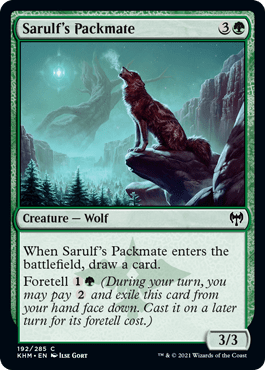

Tempo eventually
- The flip side, of course, is that you may take damage until you realize that tempo. But my first point suggests that taking damage is much less relevant than tempo loss.
- In addition, aggro decks don’t want to foretell because they are missing out on damage early, which makes it harder to close the game.
- The combination of foretell being good in slower matchups, without causing tempo loss in aggressive matchups, makes the more controlling decks much better, thus slowing down the format.
After dozens and dozens of hours of drafting and much trial and error, my actual findings were relatively similar to my initial analysis, with a few caveats.
The format is pretty slow and grindy and foretell gives most cards with the keyword a big boost.
That said, foretell cards don’t always provide you with tempo when cast. Examples include Skull Raid, Behold the Multiverse (still the second best common) and Mammoth Growth.
These non-tempo cards gain much less of a boost from the keyword than cards like Sarulf's Packmate, Demon Bolt, and Iron Verdict. This isn’t to say they aren’t good cards, or that they are worse because of foretell. It's merely a rule of thumb to analyze how good cards with foretell are, and how much they each allow you to replace your curve pieces.
One difference from my initial analysis is that it is still important to draft a curve, but foretell simply allows you to replace what would normally be 2- or 3-drops with foretell cards.
Another difference is that the red decks can actually burn you out or go wide later somewhat easily, contrary to other recent formats. So while tempo is still how aggressive decks win, you can’t completely ignore early damage.
My main conclusion is that my initial impression went a little overboard on foretell slowing the format down and replacing curves, but Kaldheim is still slower than recent formats, in part due to foretell.
Aggro decks can and are still great with the right tools and as the meta develops and people realize how good snow is, aggro will become a much better option.
To summarize, foretell slows the format down a lot by giving slower decks cards that are good against both aggressive and controlling decks, but you have to make sure you are including the correct ones, and you still have to draft with your curve in mind.
Snow is Back, Baby!
I see a lot of people talking about needing to learn how to draft snow, and how it changes the format. I don’t like this interpretation and prefer to think of snow not as an archetype, but a collection of micro synergies between all the snow spells and all the snow lands.
Yes, obviously snow can still be an archetype, if you just draft some combination of U/G/x and jam every snow card you see in there. In fact, this is one of the better decks in the format when it's open.
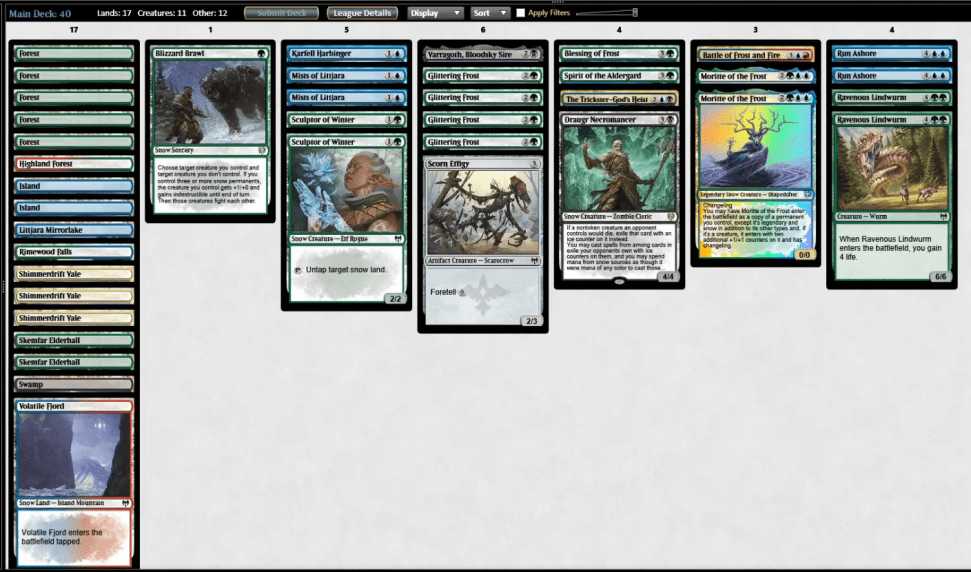
The full monty
But beware when trying to go full snow, because more people playing snow cards or going full snow in your pod makes your deck worse at a higher rate than with other archetypes.
This is because in order for your heavy snow decks to function, you need a critical mass of both good snow cards and good snow lands, and so do the other drafters. So your trainwreck snow deck is going to look a lot worse than your trainwreck RW aggro deck.
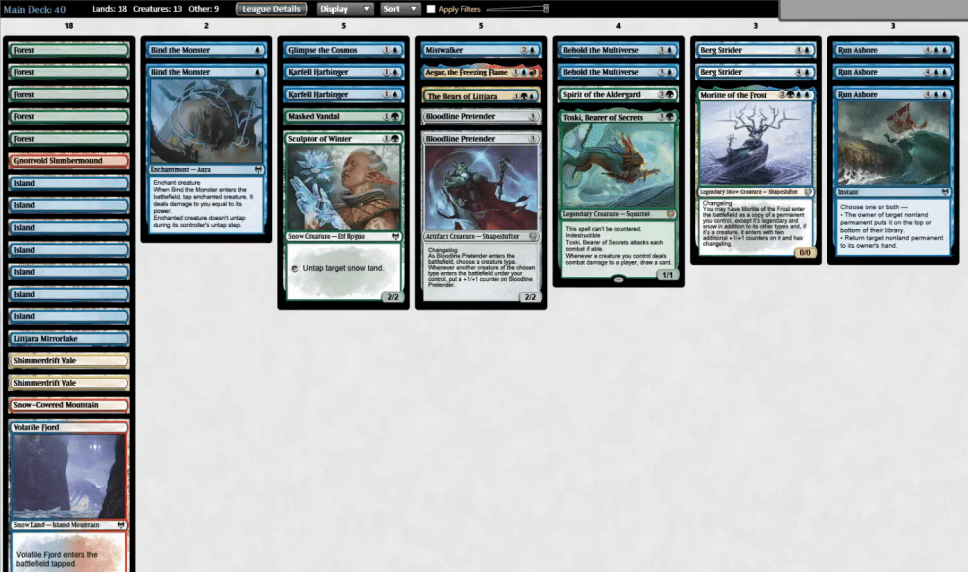
A splash of snow
Luckily, you don’t have to be a “Snow Deck” to play snow cards, and if you limit yourself to all or nothing you will lose a lot of equity. Some prime examples are Sculptor of Winter and Berg Strider, cards with huge upsides that only require a single snow land in play to turn into amazing-rate creatures.
If you see cards like this going late, but you don’t feel like you are going snow, there is still a lot of upside to gain from picking them and trying to get a couple snow lands. For reference, my number of snow lands minimum is three for Strider and five for Sculptor.
Don’t forget, taking a U/R snow dual in your only-blue or only-red deck is perfectly fine, and a good deal of the time, a tapped snow land will be worth more than a basic. Especially combined with the potential splash equity.
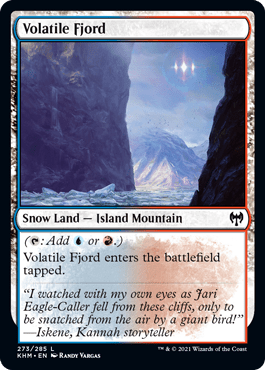

I have a bit of bias here, since on MTGO snow is pretty darn underdrafted right now. This could be causing me to overrate snow and potentially underrate aggro since my snow decks are all so powerful and consistent. Also some commons are still going way later than they should (more on that later).
To summarize, snow doesn’t have to be an entire archetype, you can very easily just play a couple snow cards and snow lands. You should also consider how open snow is before fully committing to it, since when it isn’t open your deck will be a lot worse, and that's if you can even make your playable count.
Color Rankings
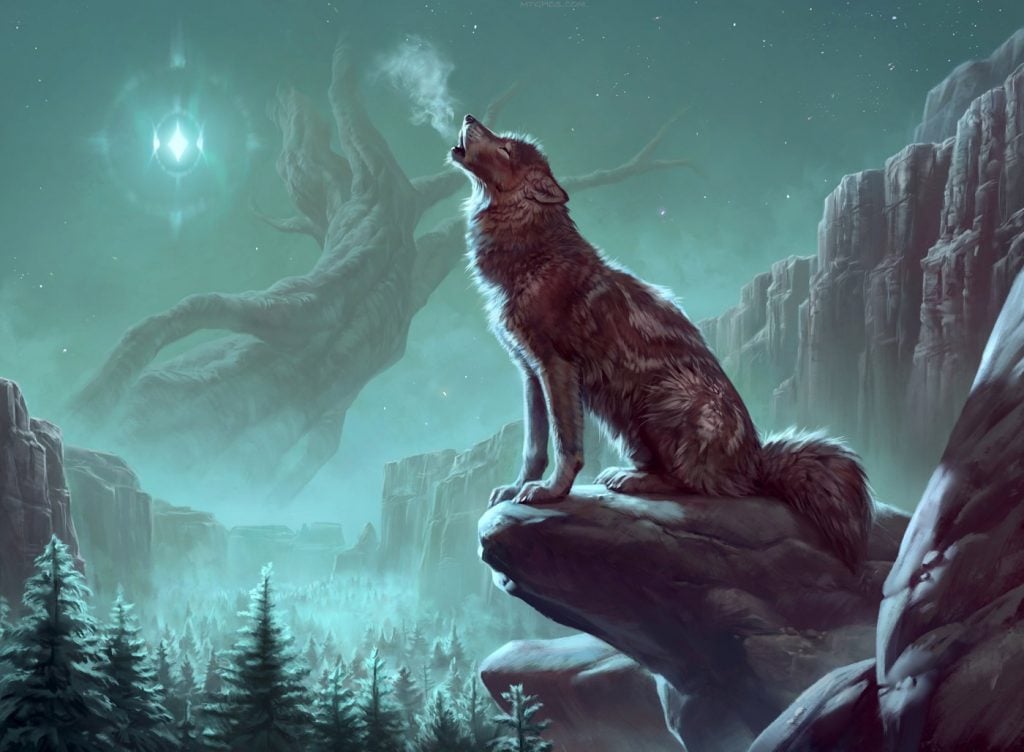
Sarulf's Packmate | Illustration by Ilse Gort
Blue / Green
As I talked about earlier, snow cards are very above-rate. These are also the two main non-aggressive colors, allowing them to benefit the most from foretell. When combined, both foretell and snow make blue and green the best colors by a pretty sizable margin.
Red
A somewhat close second, and much higher than the next two. Lots of aggressive cards but they are high-powered enough to make competitive decks. Plus you can also make midrange red decks when combined with blue or green to make use of the good-rate creatures and removal.
White
The cards aren’t great and there is no real way to play it non-aggressively unless you are mono color splashing white, since the cards aren’t good enough to justify splashing in a 2-color deck.
The aggressive cards are ok, but mostly pretty low power. The only times white seems to be good are if you get good gold cards or it is very open and you can draft the high power fliers plus some synergy.
Black
Fundamentals don’t mean shit if your cards are all bad.
Despite having snow cards and being a not-actively-aggressive color, the cards are just so rancid compared to everything else. The snow payoffs are bad, the control cards are bad rate and very limited, the aggressive cards are okay, but just so much worse than anything you could be doing in any other color.
Avoid being base black at all costs unless you get a rare or a lot of good gold cards and uncommons to splash.
Sleeper Commons
Most people have seen a list of the “top 5 commons” somewhere or have figured it out for themselves. But arguably the much more important question is, what are the sleeper cards that go late?
Run Ashore
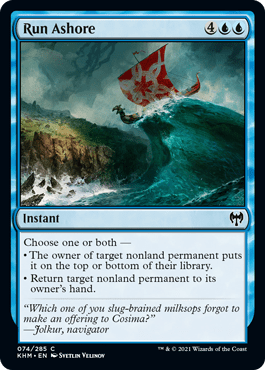
Run Ashore is easily the most underrated common in the set, and is the reason I'm almost hard-forcing blue on MTGO right now. Not only is blue one of the best colors, you regularly get Run Ashores second to last pick.
If you think about it, the worst case for this card is tempo-even and card-advantage-even. It isn’t unreasonable to assume you will be able to target two generic 3 drops. In that case, you are getting six mana worth of tempo back and they are skipping a draw (or you are killing the better creature).
Realistically though, Run Ashore is almost always much better than that because of how flexible it is. You can bounce your own stuff for value, you can push a tempo lead, you can blow out combat tricks and auras, punish vehicle activations, and sometimes you even have your opponent tap out precombat so they can’t recast their best cards that you bounce.
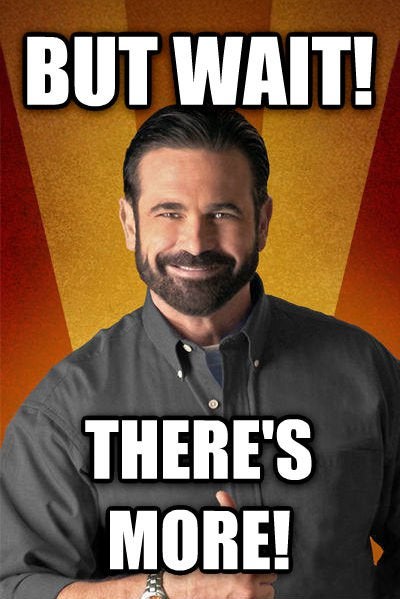
All of this and more at the low low cost of maybe having to cycle the card for free on turn 6, I’d say it’s a pretty good deal.
Raiders' Karve

I’m not sure why people aren’t high on this card. There are tons of good and cheap cards that crew it. It attacks very well while generating card advantage (and ramp?) and it blocks surprisingly well for what seems like an aggressive card.
As I mentioned before, tempo is more important than life for aggressive decks, and a 4/4 provides a lot of tempo even if it requires you to tap a 3/2. It is perfectly reasonable on blocking duty as well, as a 4/4 gums the board up very well in the early turns.
I’ve been jamming it in basically all my green decks and been very happy. It’s especially good with Sarulf's Packmate and Horizon Seeker, and it's obviously good in aggro as a 3 mana 4/4 with anti-flood assistance.
Icehide Troll
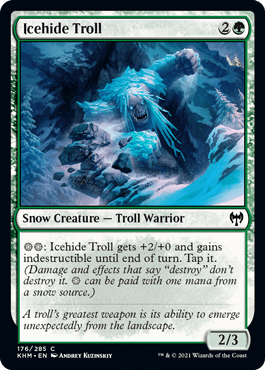
Icehide Troll may not look amazing, and while it is somewhat situational, the payoff is huge.
Sometimes you will just have to leave up two mana and it will stop most, if not all, of your opponents creatures from attacking. Other times you’ll be flooded and it will be just a 6+/3 indestructible creature that your opponent can’t beat.
All of this at the low cost of still being a 3-mana 2/3 in the event you're spending all your mana every turn or didn’t draw snow lands. The slight downside is that this card actually needs your deck to have a lot of snow lands, but currently they are still pretty easy to pick up.
Ravenous Lindwurm
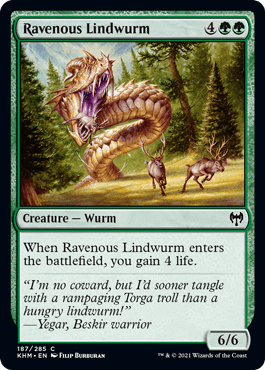
Ravenous Lindwurm is similar to the Troll in that it doesn’t look great but a 6/6 is a very nice statline in the format, 4 life is a lot, and having a nice clone/fight target is surprisingly relevant.
Dwarven Reinforcements

Dwarven Reinforcements is a surprisingly versatile card. It's good in aggro by providing multiple bodies and good because it's a foretell card that maintains or gains tempo. Plus it allows you to go wide for damage or utilize equipment later on.
In less aggressive strategies, having tempo foretell cards is very nice and 2/1s are very nice blockers in the format.
Honorable Mentions

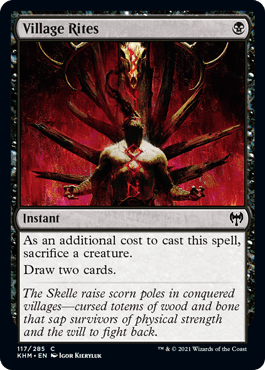
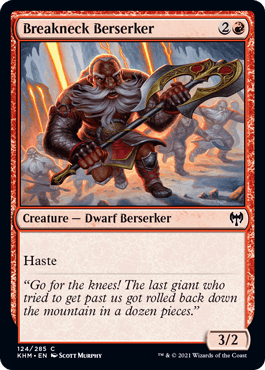
Run Amok is very good and it is what most aggressive decks are lacking, but it isn’t very flexible about which decks and situations it is good in.
Village Rites – despite black not being good, this card synergizes well with black’s less rancid commons, and gives black decks more late game potential without a huge cost.
Breakneck Berserker – similar logic to Run Amok, it's situational but very good in the right deck. Somewhat conditional on the statlines of your opponent’s creatures though.
Most Overrated Commons
Feed the Serpent
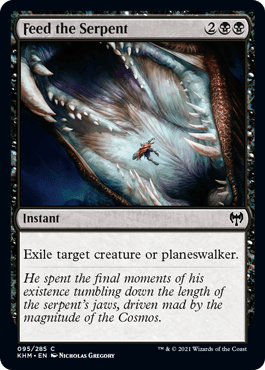
Feed the Serpent looks good, but black is unplayable and the card isn’t as good as it looks. You are often trading down on mana, and double black is a huge commitment to such a bad color for a relatively inefficient card.
Tuskeri Firewalker

Tuskeri Firewalker looks impressive at face value, but it often plays out poorly, especially compared to cards like Horizon Seeker.
It’s really awkward trying to get attacks in with it, because you can’t play any of your spells from hand, or you risk losing the boast value. Plus, since it is mainly good in aggro, its ability competes with just trying to gain tempo and kill your opponent.
It's not going to win a late game for you. Firewalker is still good in slower decks, but is certainly overrated.
Story Seeker
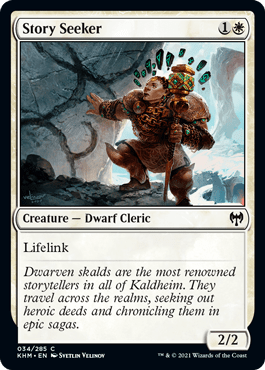
Two drops aren’t great and there isn’t a ton of aggro, making the lifelink less relevant. Even if you're in an aggro mirror, usually tempo matters much more than life.
Pilfering Hawk
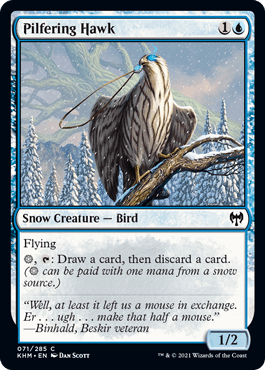
Looting isn’t great in this format. Between the sac land cycle and foretell, you end up spending almost all your mana every turn. This also makes it so that you don’t need to loot away excess lands.
A 1/2 body is also a particularly bad statline in Kaldheim. In addition, the power of cards (at least in my decks) has been pretty homogenous, so looting has less value.
Frost Bite

I know Frost Bite is great, but hear me out, it’s a little overrated.
In the decks that typically want Shock the most, it is difficult to get three snow lands. While Shock is great and a high pick, the hype is a little high.
It is also difficult and rarely worth it to play red in a full-on snow deck, and splashing red takes a way a lot of value from the card since you are much less likely to be able to cast it on time when you need it.
General Format Tips and Analysis
I talked about it earlier but wanted to reiterate, the format is surprisingly slow. You can certainly win with aggro decks, and your slower decks will close out games surprisingly quickly with so many good creatures and cards like Run Ashore, but overall it is slower than previous formats.
Fliers (can be) really good. There actually aren’t that many fliers in the set, but if you get enough, you can counter the greedier decks pretty effectively. Both slower snow and multicolored greedy decks often try to capitalize on the lack of fliers by having their tempo-providing cards mostly be ground creatures.
Plus, in order to get the late game cards and the tempo creatures they typically don’t have a ton of removal. This leaves a spot open for a deck with some fliers and tempo cards fly over the ground creatures while still being able to compete with aggro.
To supplement fliers, you often want tempo-oriented removal and bounce such as Bind the Monster and Depart the Realm. These cards also allow you to compete with the more aggressive decks. Notably, the only colors you can really do this with are exactly UW. There just aren’t any fliers in other colors and there aren’t enough in either color individually.
Having a couple removal spells is important. Unlike Zendikar Rising where you could easily make do with combat tricks, the bombs in Kaldheim are mostly creatures that provide some sort of stat boost or recurring advantage. Answering these creatures (and fliers) is important while trying to make it to, and win, the late game.
Five color decks are surprisingly viable and can be a good option if snow isn’t open. Both base-green splashing (with a good mana base):
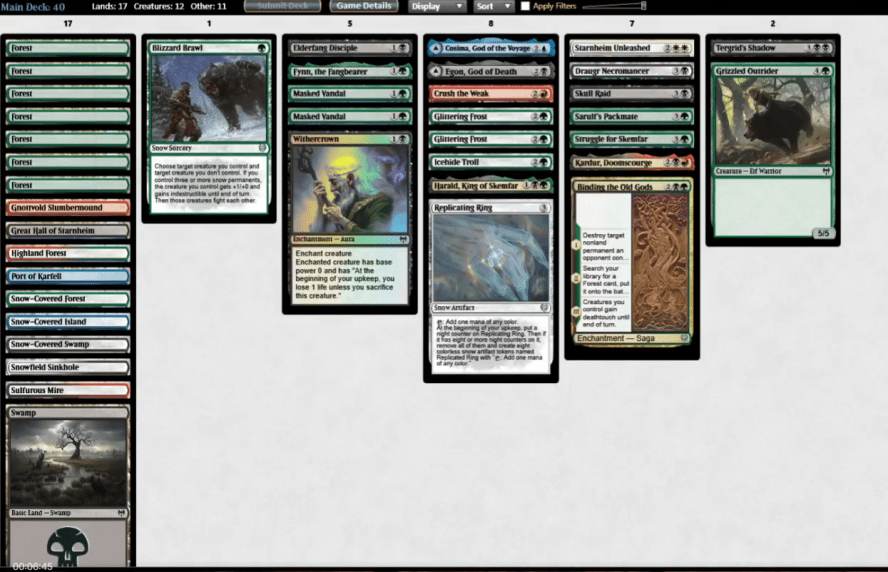
Or just ultra-greed good cards and uncommon sac lands:
The main downside of 5-color compared to snow decks is weakness to fliers and potentially, but less so, aggro decks. Five-color fixers will also help make your decks more consistent, but you don't need THAT many of them.
As much as they may not look like it, some sagas are just mediocre to terrible. This is just a quick list (in descending power level):


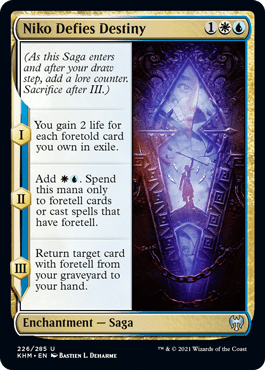
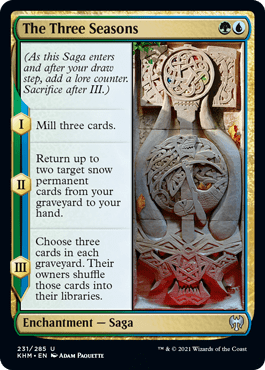
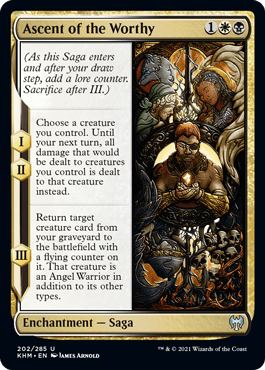
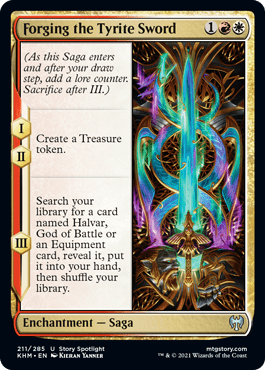
- The Trickster God's Heist
- Invasion of the Giants
- Niko Defies Destiny
- The Three Seasons
- Ascent of the Worthy
- Forging the Tyrite Sword
Make sure not to get too greedy. I preach greed a lot in this article, but what I really mean is that it is easy to get greedy without getting punished as hard as in other formats. Not that being as greedy as possible is correct.
You still have to make sure you have a curve, but that curve can just involve foretell cards instead of 2- or 3-drops. You can play 5-color but you need to have enough fixing and have a main color with some curve pieces.
Wrap Up

Run Ashore | Illustration by Svetlin Velinov
To recap, here are my main takeaways.
- Kaldheim is very complex and may be a bit intimidating to learn, but once you do it is a blast, and quite replayable too.
- Being greedy is good, and the right foretell cards can replace 2 and 3 drops in your curve.
- Snow is the best archetype by quite a bit, but you can also just put most snow cards in more generic decks with only a couple lands.
- Certain colors and archetypes are much better than others and you should be drafting with that in mind.
- Watch out for sleeper commons and fight your biases on overrated ones.
- Keep in mind format characteristics and keyword impacts when evaluating cards and while drafting.
Keep an eye out for my format review coming soon to YouTube, where I will go much more in depth on many of the points talked about here, and how my analysis has changed over time!
Also, Draftsim has now released its Ultimate Guide to Kaldheim draft, so check that out for an even more in depth guide to the format. And if you need some extra help while playing MTGA, then be sure to check out the awesome draft assistant in Arena Tutor.
Thanks for reading!
Follow Draftsim for awesome articles and set updates: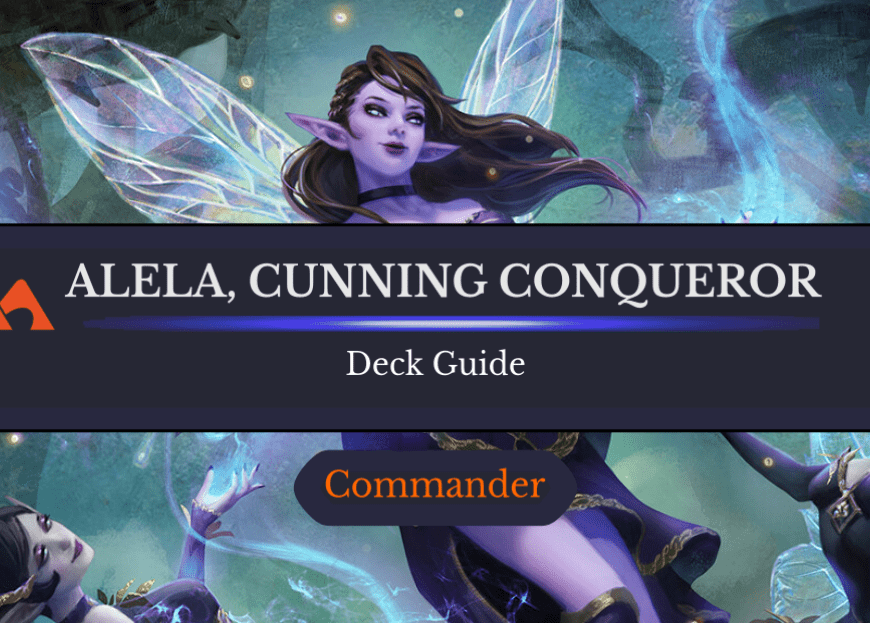
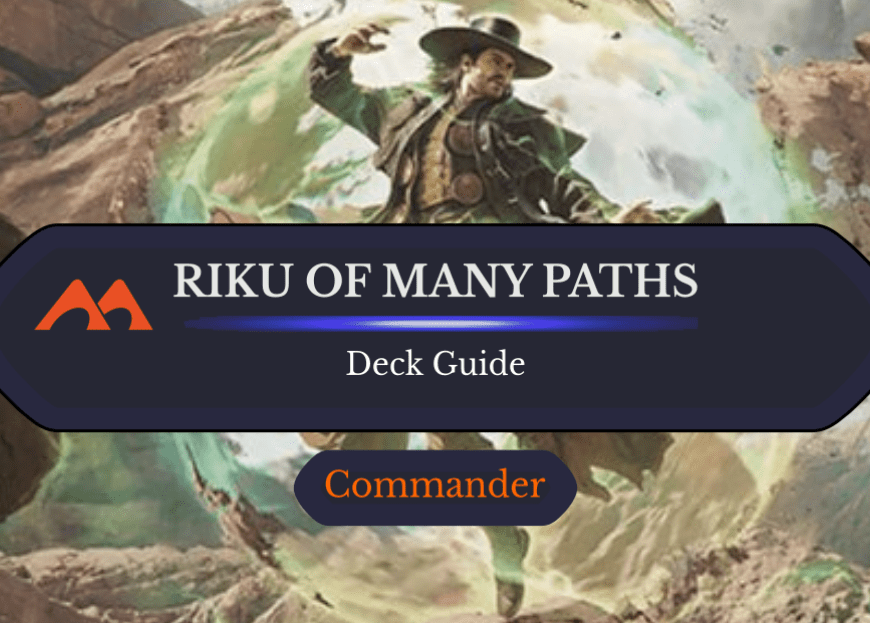
4 Comments
Thanks for this. Following your advice I just went 7-1 (first time getting 7 wins!) with UG snow. Icebind Pillar was absolutely clutch.
Awesome! So glad it helped.
You should play Skullraid 100% of the time. It has great tempo at a turn two foretell or a turn 4 punish because the format is so much slower. withercrown is also underrated in this format. it deals with large fattys and snow activated creatures that are overvalued.
Also green is overpowered.
Add Comment